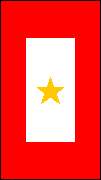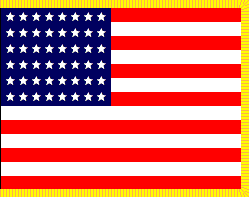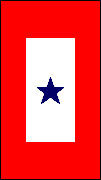BAND OF BROTHERS


US ARMY DIVISIONS OF WORLD WAR II
Distinguishing Flags
Distinguishing flags for US Army divisions of the Second World War were made of wool bunting, 3 feet at the hoist by 4 feet on the fly. All were horizontally divided, scarlet over national flag blue (for infantry and airborne divisions), yellow (for cavalry divisions) or green (for armored divisions). The authorized shoulder sleeve insignia (SSI) in proper colors was centered on the flag. If the edge of the SSI was of a color other than white or yellow, it was piped with white or yellow for contrast against the field of the flag.
Distinguishing flags were always displayed with a version of the Stars and Stripes known as the National Standard (Service). It was made of wool bunting, 3 foot hoist by 4 foot fly, with a 2 1/2-inch yellow silk fringe. The distinguishing flag and National Standard were presented to divisions during their formal activation ceremonies; thereafter they were kept at the divisional headquarters.
In this section, the flags are grouped in numerical sequence by type: infantry and mountain divisions, airborne and cavalry divisions, and armored divisions. The Philippine Division, which was lost in 1942, was maintained on the roll of the Army and in 1946 was reorganized in the Philippines as the 12th Infantry Division (Philippine Scouts). The Americal Division, organized on New Caledonia in the spring of 1942, was numbered as the 23rd Infantry Division postwar.
In general, infantry divisions numbered 1-25 belonged to the Regular Army, while those numbered 26-45 were National Guard divisions. Infantry divisions numbered 63 and above belonged to the Organized Reserves. However, when the 82nd and 101st Infantry Divisions were selected for conversion to airborne divisions in 1942, they were allotted to the Regular Army. The 1st and 2nd Cavalry Divisions and the 1st-5th Armored Divisions (all of which were activated before the US entered World War II) belonged to the Regular Army; the remaining armored divisions were part of the Organized Reserves.
There was an additional division-sized unit for which no distinguishing flag was authorized: the 1st Airborne Task Force (Provisional Seventh Army Airborne Division), organized in July 1944 for the invasion of southern France. Initially it included the US 517th Parachute Infantry Regiment and the British 2nd Independent Parachute Brigade; the latter was later replaced with the the US-Canadian 1st Special Service Force. After conducting an air assault into southern France on 15 August 1944, the 1st Airborne Task Force participated in Seventh Army's northward offensive. It was disbanded on 23 November 1944.
Credits: The drawings on these page are based on the specifications given in Army Regulation 260-10 dated 25 October 1944, a copy of which was kindly provided by FOTW Mailing List member Joseph McMillan.
